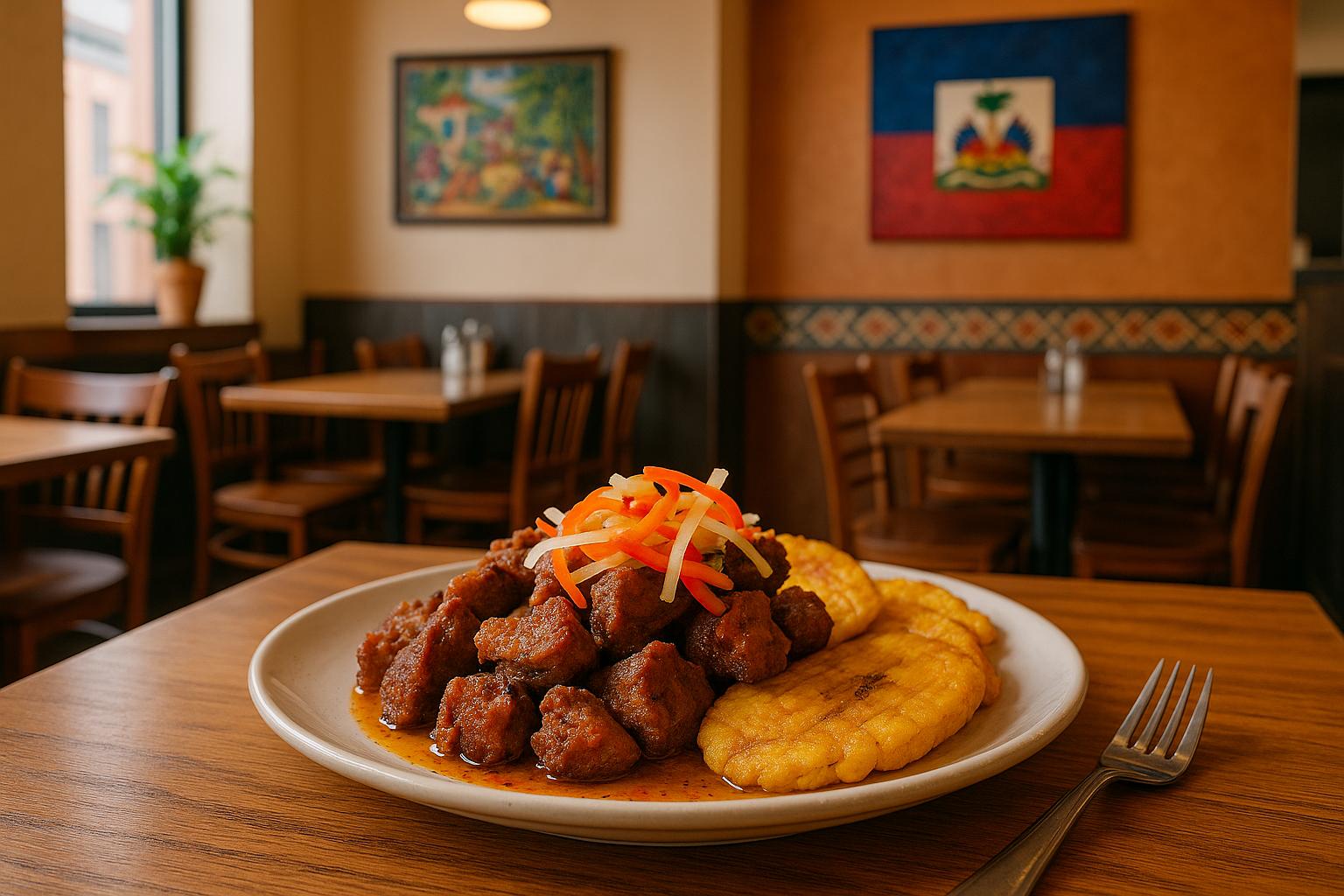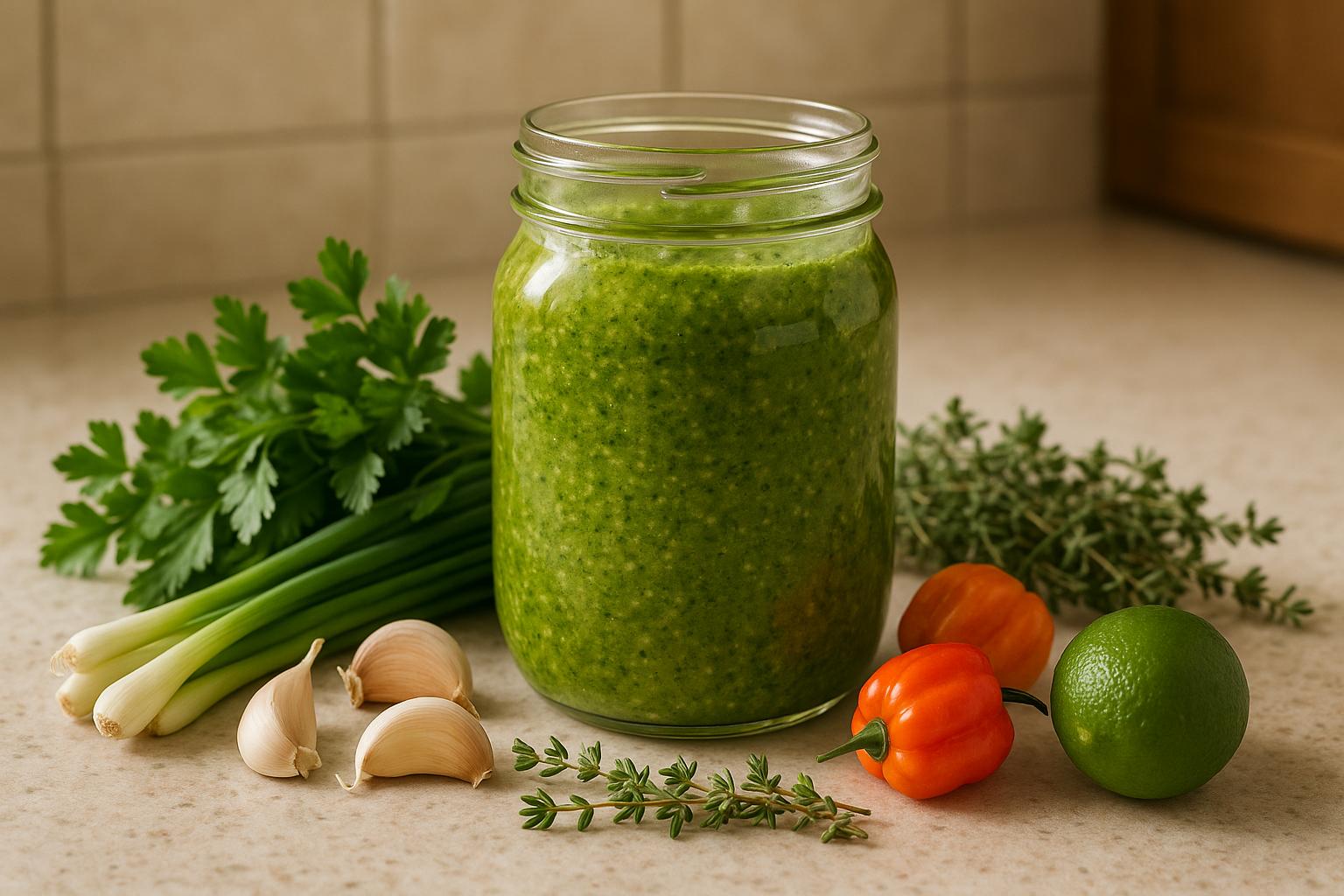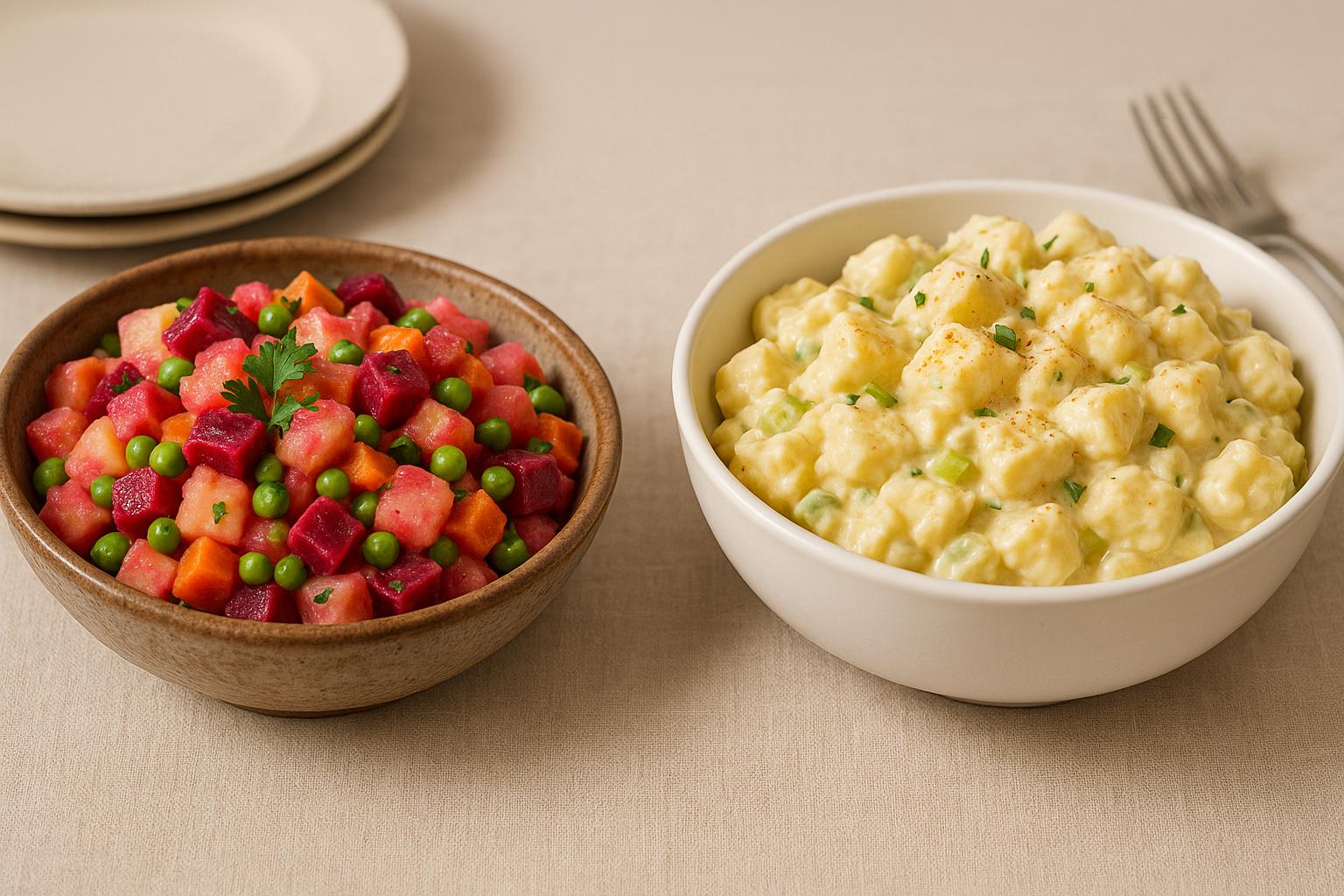In Haitian cuisine, grandmothers are the backbone of tradition, passing down recipes, techniques, and stories through generations. Their kitchens are classrooms where younger family members learn to cook not with precise measurements but through intuition, love, and storytelling. Here's why they matter:
- Guardians of Tradition: Grandmothers preserve Haitian culinary heritage, blending African, French, Taíno, and Spanish influences in iconic dishes like Soup Joumou and Griot.
- Oral Recipes: Recipes are shared through practice, not written instructions, relying on the "Tikal" method - adding "just a little bit" by feel.
- Challenges Today: Urbanization, migration, and pre-packaged foods threaten these traditions, making it harder to keep recipes authentic.
- Solutions: Families can preserve recipes by cooking together, recording them digitally, or using platforms like HaitianFoods.org.
Haitian grandmothers ensure that cooking is more than preparing food - it's about keeping culture alive.
How Grandmothers Pass Down Haitian Recipes
Teaching Through Stories and Practice
In Haitian kitchens, recipes are passed down in a way that's as much about storytelling as it is about cooking. Grandmothers often rely on something called "Tikal" - a knack for adding just the right amount of this or that. As one grandmother puts it:
"Haitian food recipes hold a vital space in the country's oral traditions, making it difficult to follow a traditional recipe with measurements. It is all about the 'Tikal,' a little bit".
Chef Widza Gustin highlights how personal stories from regions like Aux Cayes and Jérémie bring these recipes to life, showing how family kitchens are central to maintaining cultural identity. This storytelling approach seamlessly connects with the diverse cooking techniques that grandmothers have mastered over generations.
Mixing Taíno, African, and French Cooking Methods
Haitian grandmothers are the keepers of a culinary legacy that blends Taíno, African, and French traditions. This fusion comes through in signature dishes that reflect this rich heritage:
- Soup Joumou: A dish tied to Haiti’s Independence Day, it combines indigenous squash with French-inspired soup-making techniques and African spices. Once off-limits to enslaved Haitians, it became a powerful symbol of freedom after Haiti’s liberation in 1804, when it became the first Black republic in the world.
- Griot: This beloved pork dish showcases the cultural mix, with French-style preparation methods paired with epis - a flavorful seasoning base rooted in both African and French influences. It’s a centerpiece at family gatherings, where food and tradition come together.
Family Recipes and Special Occasions
Holidays and family events are prime opportunities for grandmothers to share their culinary wisdom. Dishes like macaroni au gratin, riz au petit pois, and poulet sauté often take center stage during these celebrations. These gatherings double as informal cooking classes, where younger generations learn the art of Haitian cuisine by rolling up their sleeves and getting involved.
"If you really want to teach someone anything about your culture, food is a driver for that", says Chef Stephan Berrouet Durand.
Even for families living abroad, these moments are essential for keeping traditions alive. Conversations flow in a mix of English, French, and Creole, creating a vibrant cultural exchange where recipes and stories are handed down naturally, ensuring the next generation carries these traditions forward.
Grandma Vs. Auntie: Ultimate Haitian Cook-Off | National Geographic
Modern Threats to Family Recipes
Haitian culinary traditions, lovingly passed down through generations, now face challenges that threaten their survival in today’s world.
City Life and Migration Effects
Urbanization and migration have disrupted the traditional ways families share their cooking knowledge. As more families move to cities or settle abroad, the kitchen - a space once central to learning - loses its role as a hub for passing down recipes. For Haitian-Americans, this shift is especially pronounced. Without the daily, hands-on guidance of elders, many are left disconnected from the techniques and stories that define their culinary heritage. Modern living often prioritizes convenience, making it even harder to preserve these traditions.
Store-Bought vs. Homemade Dishes
The growing popularity of pre-packaged foods poses a serious challenge to authentic Haitian cooking. Replacing homemade meals with store-bought options doesn’t just affect taste - it chips away at the cultural legacy tied to these dishes. Here’s how:
- Loss of Technique: Fewer people are making homemade epis, the essential seasoning base, from scratch.
- Compromised Quality: Mass-produced pikliz lacks the personal touch and unique flavors of family recipes.
- Cultural Disconnection: Pre-made options strip away the stories and traditions embedded in the cooking process.
This shift away from homemade meals not only impacts the flavors on the plate but also weakens the bond to family history.
Communication Gaps Between Generations
Even when families remain connected, generational divides can hinder the sharing of recipes. In diaspora communities, language barriers often emerge as a significant obstacle. Younger generations who don’t speak Creole or French fluently may struggle to follow their elders’ instructions. Other challenges include:
- Difficulty understanding traditional cooking terms or techniques described in their parents’ native language.
- A preference for precise measurements, which clashes with the intuitive “tikal” (a little bit) approach of older generations.
- A lack of familiarity with cultural references or methods deeply rooted in Haitian traditions.
These gaps can lead to recipes that lose the subtle, time-honored techniques that make them truly authentic. Over time, the essence of these dishes risks being diluted, leaving a vital piece of heritage behind.
sbb-itb-80c33ff
Ways to Save Family Recipes
Recording Recipes Digitally
One of the easiest ways to preserve cherished family recipes is by recording them digitally. Snap photos of handwritten recipes and store them in cloud services like Google Drive or Dropbox, making them accessible to the entire family. Another great idea is creating video recordings of loved ones cooking. These videos don’t just capture the recipes - they also preserve the techniques and personal touches, such as how a grandmother prepares epis or uses intuitive, non-measured ingredients.
For more organized storage, digital recipe platforms offer helpful tools:
| Platform | Annual Cost | Key Features |
|---|---|---|
| BigOven Premium | $25 | Unlimited storage, 25 recipe digitizations |
| Copy Me That | $13 | Unlimited recipes, lifetime option |
| Plan to Eat | $49 | Unlimited storage, meal planning |
While digital methods are invaluable, nothing beats the bonding experience of cooking together to keep these traditions alive.
Cooking Together Across Generations
Cooking as a family is a hands-on way to pass down recipes and techniques, especially when migration or busy schedules might otherwise create gaps. Start with simple recipes, document the process with photos or videos, and take time to learn ingredient substitutions or traditional techniques. These sessions aren’t just about the food - they’re about sharing stories, memories, and connections that make the recipes meaningful.
Here are some tips for successful family cooking sessions:
- Begin with easy, approachable recipes.
- Capture the process through photos or videos.
- Explore ingredient substitutions for hard-to-find items.
- Practice traditional cooking methods.
- Share family stories while preparing meals.
Cooking together not only preserves recipes but also strengthens family bonds, ensuring that traditions are passed on naturally.
Using HaitianFoods.org for Recipe Sharing

For families looking to share their recipes more broadly, HaitianFoods.org is a fantastic platform. Through its blog, families can upload their treasured recipes, share the history behind them, and include useful cooking tips. This platform serves as a bridge, keeping Haitian culinary traditions alive while making them accessible to others who want to learn and appreciate the culture.
"Our time with our loved ones is so precious, and being able to capture those recipes down - even if it's just a quick summary or a rough draft - is such an important way to preserve family history and keep traditions and culture alive" [7].
Local Groups Keeping Recipes Alive
Food Events and Festivals
Community gatherings play a vital role in celebrating and preserving traditional cooking methods. Take Haiti's Independence Day on January 1st, for example - Joumou soup, a dish symbolizing freedom, takes center stage during these celebrations.
On October 19, 2023, the Haitian community hosted an event called "JOUNEN RETWOUVAY AK MANJE AYISYEN." This gathering highlighted beloved dishes like joumou soup, chiktay, and griots, promoting local ingredients and supporting national producers. These festivals often include live cooking demonstrations where grandmothers pass down their culinary wisdom to younger generations.
"Haitian culture is vibrant, full of stories and history." - Chef Alain Lemaire
Events like these often spark other community-driven efforts that further preserve and celebrate Haiti's rich culinary traditions.
Finding Local Haitian Restaurants
Outside of festivals, local Haitian restaurants play a key role in preserving and sharing traditional recipes. These eateries offer an alternative to home-cooked meals while keeping authentic flavors alive. Community directories often highlight these establishments, making it easier to connect with Haitian cuisine.
Some restaurants have even become cultural staples. In Miramar, Florida, La Paix Bakery serves as a gathering spot for Haitian food lovers, offering dishes like their signature creole sauce. Meanwhile, in Portland, Oregon, Kann restaurant not only serves Haitian classics like griyo but also educates diners about the cuisine's roots.
"It would defeat the purpose of having a Haitian restaurant if you're not walking away and going, 'I know what Haitian food is now.'" - Gregory Gourdet, Chef
Teaching Haitian Cooking in Schools
Passing down recipes isn't just happening at home - schools are stepping in to ensure younger generations stay connected to their culinary heritage. The Haitian Culinary Alliance (HCA) leads the way with its "Cooking With Kids Program" in North Miami, where students learn traditional techniques firsthand. The HCA's dedication goes beyond the U.S.; they’ve even donated 50 knife kits to the Haitian Hotel School in Port-au-Prince.
Another standout initiative is EatWell Exchange's "Manje Pou Viv" program at the Little Haiti Cultural Arts Center. Over six weeks, participants learn healthier takes on traditional recipes while staying true to authentic methods. The program also offers hands-on cooking classes for 40 participants and provides free health screenings.
"The greatest accomplishment one can have, is knowing that you have shared your passion and knowledge with others." - Stephan Durand, Chairman, President and Co-Founder of the HCA
Conclusion: Keeping Grandmother's Recipes for the Future
Preserving Haitian culinary traditions is about more than just food - it's about honoring a rich cultural legacy. As Dr. Marlene Daut of Yale explains, "The entire geography of our country would look completely different if it were not for the Haitian Revolution and for Haiti". This deep historical significance extends to the heart of Haitian homes: the kitchen, where grandmothers have long been the guardians of authentic flavors and techniques.
Digital platforms like HaitianFoods.org play a key role in documenting and sharing these recipes, creating a bridge between the past and the present. By recording traditional methods, these tools help ensure that the essence of Haitian cuisine survives, especially for the Haitian diaspora - one of the largest foreign-born communities in the United States.
But no digital archive can replace the hands-on knowledge passed down through generations. Haitian women, often the storytellers and keepers of family traditions, embody the connection between food and heritage. As Stephan Berrouet Durand puts it:
"I think food is universal and food brings people together. If you really want to teach someone anything about your culture, food is a driver for that."
Gaëlle echoes this sentiment, adding:
"For Haitians, food is seen as more than just sustenance; it is a celebration of the past, a tribute to the community that nurtured these traditions, and a promise to those who will continue them in the future."
Efforts to document traditional Haitian recipes aren't just about listing ingredients - they capture the sensory experiences, the techniques, and the stories behind each dish. This ensures that future generations can not only recreate these meals but also understand their deeper cultural significance.
The future of Haitian cuisine lies in blending preservation with evolution. By combining the wisdom of grandmothers with modern tools, we can protect the soul of Haitian culinary traditions and pass them on, ensuring they remain a vibrant part of the community for years to come.
FAQs
How can families preserve Haitian cooking traditions despite modern challenges like urbanization and processed foods?
Preserving the rich traditions of Haitian cooking in today’s fast-paced world takes deliberate effort. Grandmothers often hold the key, serving as guardians of cherished recipes and techniques, which they pass down through stories and hands-on cooking sessions. Families can nurture these traditions by spending time in the kitchen together, learning from their elders, and recording recipes to make sure they’re never lost.
Tweaking traditional dishes to incorporate locally available ingredients is another way to keep the spirit of Haitian cuisine alive while adapting to modern needs. Hosting family meals or taking part in cultural events centered around Haitian food can also spark interest in younger generations, encouraging them to take pride in and carry on these practices. These small but meaningful actions help ensure that Haitian culinary heritage continues to thrive.
Why are Haitian grandmothers so important in preserving traditional dishes like Soup Joumou and Griot?
Haitian grandmothers are the guardians of tradition, ensuring that cherished dishes like Soup Joumou and Griot remain a vibrant part of family life. Through their hands, recipes, cooking techniques, and the stories tied to these meals are lovingly passed down, keeping the essence of Haitian heritage alive.
Take Soup Joumou, for instance. It’s not just a dish - it’s a powerful symbol of freedom and independence. Served every New Year’s Day, this soup commemorates Haiti’s hard-won liberation from colonial rule. On the other hand, Griot, a mouthwatering pork dish, is a centerpiece of family gatherings and celebrations, representing the warmth and togetherness that defines Haitian culture.
By teaching the next generation, these grandmothers do more than preserve the bold flavors of Haitian cuisine. They weave a tapestry of family bonds and cultural pride, ensuring these traditions thrive for years to come.
How can digital tools and community events help preserve Haitian recipes and cooking traditions across generations?
Digital tools and community events play a key role in keeping Haitian recipes and cooking traditions alive. Online platforms offer families an easy way to record and share recipes, cooking techniques, and the rich stories behind their favorite dishes. These digital resources help younger generations stay connected to their culinary roots, even when they’re miles away from home.
Community events, like cooking workshops or food festivals, provide a more hands-on way to learn. Elders, often the keepers of traditional Haitian cooking, can pass down their skills and knowledge to younger family members in a personal and meaningful way. These gatherings do more than just preserve culinary traditions - they bring families and communities closer together, ensuring that Haitian cuisine continues to flourish for years to come.


